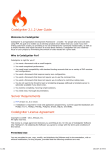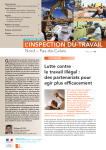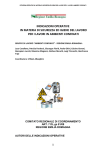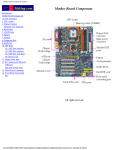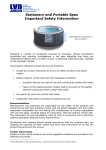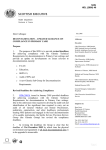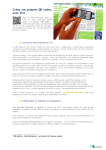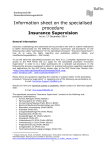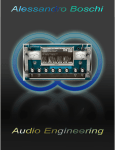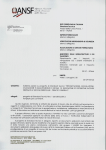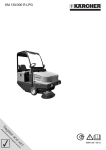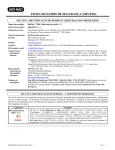Download Safe maintenance - Portable tools in construction
Transcript
54 SAFE MAINTENANCE OF PORTABLE TOOLS IN CONSTRUCTION Introduction to maintenance Maintenance can be defined as working on something to keep it in a functioning and safe state and preserving it from failure or decline. The “something” could be a workplace, work equipment, or means of transport (e.g. a ship). Preventive – or proactive – maintenance is carried out to keep something functional. This type of activity is usually planned and scheduled. Corrective – or reactive – maintenance is repairing something to get it working again. This is an unscheduled, unplanned task, usually associated with greater hazards and higher risk levels. Maintenance is not the exclusive domain of fitters and mechanics. It is the responsibility of almost all workers in every sector and is carried out in almost every working environment. Workers’ health and safety can be affected during the maintenance process, but also by lack of maintenance or inadequate maintenance. Design of equipment and the work area also has a significant impact on the health and safety of workers performing maintenance. For the purpose of this e-fact, portable tools are defined as tools which can be carried by hand. These tools can be divided into non-powered portable (hand) tools and powered portable tools. Non-powered portable (hand) tools include saws, hammers, screwdrivers, pliers, axes and spanners. The greatest hazards posed by these tools result from misuse and improper maintenance. Blunt tools, for example, can make the work more difficult and result in more injuries. Powered portable tools There are several types of power tools, based on the power source they use: electric power operated tools (e.g. circular saws, drill machines), pneumatic power tools (e.g. hammers, chippers, compressed air guns), liquid fuel (gas) powered tools (e.g. saws), hydraulic power tools (jacks), and powder-actuated tools (nail guns). Powered portable tools are present in nearly every industry. They help to perform tasks that otherwise would need exhausting manual work. But these everyday tools can cause serious injuries, such as finger or hand injuries or severe eye injuries, when they are not used or maintained properly. Broken (defective) tools, or tools that have been modified unprofessionally can be dangerous. For instance, defective electric-powered tools can cause burns and shocks or even death through electrocution. Pneumatic tools can be very noisy and cause hearing loss. Portable tools are used intensively on construction sites, so that the workers are constantly exposed i to hazards associated with their use. According to a survey, non-powered hand tool injury rates were second highest in construction, outranked only by agriculture. For power tool injury rates, the order was: construction, agriculture, manufacturing, and mining. ii Approximately half of all finger amputations each year are caused by accidents involving powered tools. iii. According to ISSA (2009) iv the ratio of portable electrical equipment accidents to all electrical accidents is approximately 1:5 and the University of Wolverhampton (2006) v observed that almost a quarter of all reportable electrical accidents involve portable equipment. This corresponds to the findings by HSE according to which nearly a quarter of all reportable electrical accidents involve portable equipment. vi Special attention must be paid to the maintenance of portable tools to prevent or eliminate hazards. Control and maintenance of portable tools at construction sites is a challenge due to the nature of construction sites and because, by their very nature, portable tools are easily transported. Accidents can also occur during maintenance of defective powered tools. European Agency for Safety and Health at Work - http://osha.europa.eu 1 Safe maintenance - Portable tools in construction ® Kadmy - Fotolia Hazards and risks associated with poorly maintained portable tools on construction sites Poorly maintained portable tools in construction (either hand tools or powered tools) present significant health and safety risks to the workers using them. These risks are proportional to the state of repair of the tools and increase through time. Ad hoc repair of damaged equipment is often carried out on construction sites to keep the work going. Such repairs are frequently done in hurry, in an offhand manner, often involving improvised solutions (e.g. replacing a fuse with a nail, taping up damaged electric cable). Unprofessionally repaired equipment can be dangerous. Hazards and risks induced by lack of or inadequate maintenance include: Hand tools: Mechanical failure or loss of control when using a tool with defective parts. Examples of unsafe tools are hammers with loose or damaged heads, screwdrivers with broken handles or blunt edges, chisels with mushroomed heads, and blunt saws. Power tools: Malfunctioning of safety devices such as emergency button (red button), protective covers, guards, etc. In case of emergency these devices will not work properly or will provide limited protection to the worker, which in some cases can be worse than no protection at all because it gives a false sense of security. Risks of electrocution, shock or burns due to electrical malfunctions, torn cables and lack of proper insulation or proper earthing. Cracked or broken grinding wheels or cracked blades can cause injuries. E.g. cracked abrasive wheels could fly apart in operation, which could lead to serious injury or death. Emissions of chemical substances such as toxic fumes or dust, etc. Noise and vibration emitted by almost all portable tools that can lead to hearing loss and hand–arm vibration syndrome respectively. Vibration can cause “white-finger” disease, which arises from damage to the muscles and nerves that control the blood flow. Poorly maintained tools can cause a significant increase in noise and vibration emissions (e.g. a cutting tool that is not sharp emits higher levels of vibration). Also, damaged anti-vibration mountings in a tool can increase transmission of vibration to the worker. European Agency for Safety and Health at Work - http://osha.europa.eu 2 Safe maintenance - Portable tools in construction Preventing hazards associated with the use of hand and power tools through maintenance Constant care and adequate maintenance and storage are essential for the safe use of portable tools at construction sites. In practice, this involves daily visual inspections aimed at detecting signs of possible fault; for example, oil or coolant leaks, structural cracks, or cutting-edge wear. This also includes the mechanical adjusting and tune-up of equipment and the detection and correction of small problems before they become major problems. Items requiring attention should be reported. Some basic rules to prevent hazards associated with the use of hand and power tools are: Examine each tool for damage before use Check that the guards are present and secure Check wheels and blades for cracks Check electrical cords, connections, earthing. It is essential that the earth core of the flexible cable and associated earth connections of portable electric tools are tested regularly by a competent person to ensure continuity and strength of the earthing. Many electrical accidents are caused by faulty flexible cables, extension leads, plugs and sockets .What should you look for during the inspection? Are any bare wires visible? Is the cable covering undamaged, free from cuts and abrasions? Is the plug in good condition, e.g. the casing is not cracked and the pins are not bent? Are there taped or other non-standard joints in the cable? Is the outer case of the tool undamaged? All portable tools that are damaged should be removed from use and tagged “Do Not Use” Keep tools sharp and clean Replace badly worn, cracked or out-of-round wheels, worn and cracked blades Replace all frayed and/or damaged extension cords, damaged connections. Do not try to tape cords Follow instructions in the user’s manual for lubricating and changing accessories Maintain tools according to the manufacturer’s specifications to avoid worsening vibration: Replace vibration mountings before they are worn out Check rotating parts for balance and replace them if necessary Keep tools sharp. Examples of tools that can cause vibration injury: Chainsaws Concrete breakers, pneumatic drills Hammer drills Hand-held grinders Power hammers European Agency for Safety and Health at Work - http://osha.europa.eu 3 Safe maintenance - Portable tools in construction To remain safe, hydraulic systems need to be properly maintained. All hydraulic hose assemblies need to be periodically replaced. Establish a maintenance schedule and follow it consistently. Check all hydraulic hoses for cuts, abrasions, cracks, and other signs of damage before use. Inspect/replace critical hydraulic hose assemblies more often. Critical hose assemblies are those that are close to the equipment operators or whose failure could result in injury In addition to minimising the hazards related to the use of portable tools, proper service and maintenance keeps equipment working efficiently; so service and maintenance should be seen as a contribution to productivity. What are the risks for workers maintaining portable tools? Maintenance is a vital procedure for the safe and proper function of the equipment, and therefore workers should have proper training. However, the process of maintenance is in itself a challenge for occupational health and safety. In addition to all the hazards and risks already present on construction sites, such as slips, trips, falls, noise and moving vehicles, maintenance of portable tools bears specific risks such as: Risks of shocks, burns, and electrocution if tools are not disconnected before servicing or maintenance workers don’t use protective equipment such as shoes and gloves and the proper tools, if electric tools are not properly earthed or if plugs are not protected by Switched Protective Earth-Portable Residuals (SPE-PRCD). Risk of injury by moving parts of the tool that can happen during inspection for diagnosis, during maintenance (if total deactivation and disconnection of the tool has not been carried out) and finally during re-commissioning. Risks of injury by moving parts due to accidental release of hydraulic/pneumatic energy of the tool. Pressure systems must be shut down and the valves must be secured before maintenance starts. Risk of injury by moving parts due to accidental release of mechanical energy (e.g. springs) of the tool being maintained. Risk of injury by accidental fall of non-secured parts or tools during maintenance. Risk of injury by high-pressure fluid from hydraulic tools. Remember that hydraulic oil is under high pressure. Release the pressure before working on the system. When inspecting the equipment, never touch pressurized hoses with your hands, not even with gloved hands. Fluids under high pressure are dangerous and can cause serious injury or death. Risk of burn from hot oil in hydraulic tools. Risk of fire or explosion of flammable materials in the working equipment. Maintenance work may cause ignition of flammable materials (from heat sources like cigarettes, static electricity and electric discharges, fuel in portable tools, etc.). European Agency for Safety and Health at Work - http://osha.europa.eu 4 Safe maintenance - Portable tools in construction ® Sima - Fotolia NEVER touch a pressurized hydraulic hose with your hand to locate a leak and get to an emergency room right away if you suspect an injection injury has occurred! OSH management and maintenance The Framework directive obliges the employers to take the necessary measures to ensure the health, safety and welfare of all their workers including those involved in maintenance. Employers have to carry out a workplace risk assessment to identify hazards related to the use and maintenance of portable tools and take preventive measures to eliminate or minimise the risks. Companies contracting out maintenance work have to make sure that the contractor is managing occupational health and safety according to the legal requirements. Maintenance and inspection programmes The key to safe maintenance is putting in place a maintenance programme, integrating safety and health aspects of maintenance and including inspection, reporting and record keeping procedures. Records must be kept to provide information for planning maintenance and replacement activities so that they occur at the proper time. Proper maintenance management of equipment requires a detailed inventory of all major items, including among other things information on manufacturer, model, year and number, and a list of the parts required for normal service and major repairs respectively. An important part of the maintenance programme is the inspection programme setting out the frequency of formal inspections to be carried out by competent and trained maintenance technicians. Portable tools must be checked: Before the tool is put into use for the first time After servicing and changing parts At regular intervals appropriate for each tool. The period between inspections can vary, depending on the type of tool, the conditions of use and the environment. In Germany there are technical rules and accident prevention regulations that give advices on how to identify and set maintenance intervals for powered portable tools. vii,viii The Health European Agency for Safety and Health at Work - http://osha.europa.eu 5 Safe maintenance - Portable tools in construction and Safety Executive in the UK also provides information regarding the maintenance of powered portable equipment, including inspection intervals. ix Factors to consider when making the maintenance plan (adapted from HSE x ): Type of tool and power source Manufacturer’s instructions and recommendations Age of the tool Frequency of use and the work cycle of the tool Working environment in which the tool is used (e.g. wet or dusty), or likelihood of mechanical damage Foreseeable misuse of the tool Effects of any modifications or repairs to the tool Analysis of previous records of maintenance. Do maintenance safely: Always disconnect powered tools before servicing, adjusting, oiling, cleaning or repairing them, sharpening or changing accessories such as blades. Follow the manufacturer’s instructions in user’s manual for maintenance and servicing (e.g. lubrication, cleaning) and changing parts and accessories. Use appropriate tools and equipment while carrying out maintenance Don’t modify or alter tools. Never remove guards. Don't tie them back or modify them either. Don’t modify safety features built into switches Personal protective equipment The hazards and risks already present on construction sites, such as slips, trips, falls, noise, moving vehicles, and the specific risks related to the maintenance of portable tools frequently require the use of personal protective equipment. For example, safety helmets must be worn in areas where overhead hazards exist. Hand protection and gloves must be worn where workers have to work with sharp tools. Use of e.g. lubricants, hydraulic fluids or cleaning agents (solvents) may cause eye or skin injuries and requires protection. Ear protection may be necessary when working with or near noisy machines or equipment. Training and information Workers involved in maintenance have to be trained and informed about the task, the results of the risk assessment, the safe systems of work and procedures, including reporting of problems. The maintenance of powered portable tools has to be performed by competent staff and carried out in accordance with manufacturers’ instructions and recommendations. Workers involved in maintenance must know which tools are used and where they are stored, and they must understand and follow the safety precautions. Some tasks need specific training, such as hydraulic training to carry out maintenance of hydraulic tools. Do not make modifications, repairs or adjustments to any hydraulic system unless you are competent. Final check When maintenance is complete workers have to check if the maintenance has left the portable tools in a safe and functioning condition: xi Test the functionality of the tool Replace all guards and safety devices Record your inspection and actions, sign out and pass the tool to the worker or store it safely. European Agency for Safety and Health at Work - http://osha.europa.eu 6 Safe maintenance - Portable tools in construction Checklists A checklist can help you identify the hazards related to maintenance of portable tools and take the necessary preventive measures. Depending on the power source, different checklists may be necessary: General questions Yes No Yes No Yes No Yes No Is there a maintenance plan? Are portable tools periodically tested and labelled with the date of test? Are instructions and operating manuals available? Are damaged tools labelled “do not use"? Are maintenance records kept of all tools that are used on the site? Are all tools used at the workplace in good condition and clean? Are all tools properly lubricated? Are blades, bits, and other cutting parts sharp and well fixed, and not worn, cracked or loose? Are tools stored in a dry and safe place? Are blades removed when tools are being transported, stored or not in use? Are maintenance workers trained in safe working procedures? Electric power operated tools Are tools disconnected from the power source? Are the cables or plugs damaged? Have the electrical tools been put to unsuitable conditions (wet or dusty)? Are flexible extension cables in safe condition? Are there signs of overheating? Do all tools have safety guards on their blades, bits, rollers, chains, gears, sprockets, and other dangerous moving parts? Powder-actuated tools Are the tools unloaded when being maintained? Are the barrels free from obstructions? Are the barrels of a loaded or unloaded powder-actuated tool always pointed in a safe direction away from the operator’s body and at no time pointed towards any person? Are the tools inspected and tested daily? Are the tools equipped with protective shields or guards? Pneumatic power tools Is the air supply stopped? Are hoses in a good condition and appropriate for the tool? Are the tools always pointed in a safe direction away from the operator’s body and at no time pointed towards any person? Are safety clips installed to prevent attachments, such as chisels on a chipping hammer from unintentionally shooting from the barrel? European Agency for Safety and Health at Work - http://osha.europa.eu 7 Safe maintenance - Portable tools in construction Hydraulic power tools Yes No Are there any signs of external damage on hydraulic hose assemblies, such as cuts, abrasions, cracks, and other? Is the pressure released before working on the system? Tool design Design for good maintainability helps to facilitate the maintenance of portable tools and reduces safety risks. All components and interfaces should be designed and located so that they are directly and easily accessible for maintenance xii . Maintenance tasks should be designed to eliminate or minimise the need for special tools. Good design can significantly contribute to eliminating or reducing the opportunity for human error during maintenance. Legislation European directives set minimum standards to protect workers. The most important is Council Directive 89/391/EEC, the Framework Directive, on the introduction of measures to encourage improvements in the safety and health of workers at work that sets out the risk assessment process and a hierarchy of prevention measures that all employers are required to follow. The Framework Directive is supplemented by individual directives, of which the construction site is especially covered by Directive 92/57/EEC – which lays down minimum safety and health requirements for temporary or mobile construction sites. It requires that installations, machinery and equipment, including hand tools, must kept in good working order and contains provisions on technical maintenance, pre-commissioning checks and regular checks on installations and equipment with a view to correcting any faults which might affect the safety and health of workers. The use of work equipment is covered by Directive 2001/45/EC concerning the minimum safety and health requirements for the use of work equipment by workers at work. It contains minimum requirements for control and protection devices and provisions concerning maintenance of work equipment, as well as specific provisions on periodic inspections. Directive 89/654/EEC concerning the minimum safety and health requirements for the workplace stipulates that technical maintenance must be carried out in the workplace and on the equipment and devices used there, and any faults found which are liable to affect the safety and health of workers must be rectified as quickly as possible. Directive 89/656/EEC on the minimum health and safety requirements for the use by workers of personal protective equipment at the workplace regulates the minimum requirements for personal protective equipment used by workers at work. Many portable tools at construction sites are powered by electricity. The Directive 2006/95/EC (“The Low Voltage Directive”) covers all health and safety risks, requiring that electrical equipment is safe in its intended use. The objective of Directive 2006/42/EC is to lay down the essential health and safety requirements in relation to design and manufacture in order to improve the safety of machinery placed on the market. The Directive stipulates that machinery must be designed and constructed so that it is fitted for its function, and can be operated, adjusted and maintained without putting persons at risk. A number of individual Directives have been enacted controlling the exposure of workers to potentially damaging physical agents in the workplace such as vibration and noise. These directives include a provision aimed at avoiding or reducing exposure among others by means of appropriate maintenance programmes for work equipment. European Agency for Safety and Health at Work - http://osha.europa.eu 8 Safe maintenance - Portable tools in construction For more information on legislation see http://osha.europa.eu/en/legislation Many standards may also apply to safe maintenance of portable tools at construction sites. For example CEN/TC 255 for the safety of hand-held, non-electric power tools and CEN/TC 213 for the safety of cartridge operated hand-held tools. Or ISO 2380-1 with tips for hand- and machine-operated screwdrivers. Useful links ISSA, Guideline on Managing Safety in the Use of Portable Electrical Equipment in the Workplace, International Section of the ISSA for Electricity, Gas and Water, IVSS, 2009 http://www.issa.int/ger/content/download/80356/1562921/file/2Guideline_portable_electrical_equipme nt.pdf University of Wolverhampton, Guidance for the registration, inspection and testing of portable electrical equipment, 2006 http://www2.wlv.ac.uk/hs/guidance/RSH%20Guidance%20%20Portable%20Electrical%20Safety.pdf Berufsgenossenschaft der Bauwirtschaft, D 10 - Handmaschinen, http://www.bgbaumedien.de/site/asp/dms.asp?url=/bau/infom/d10.htm Vereinigung der Metall-Berufsgenossenschaften, Sicherheit beim Arbeiten mit Handwerkszeugen, BGI 533, 2007, http://www.bgbau-medien.de/pdf2/zh_Z71.pdf Health and Safety Executive HSE, Maintaining portable and transportable electrical equipment, HSE Books, second edition 2004, http://www.hse.gov.uk/pubns/priced/hsg107.pdf i Myers, J.R., Trent, R.B., Hand tool injuries at work: A surveillance perspective, Journal of Safety Research, Volume 19, Issue 4, 1988, pp. 165-176. ii Myers, J.R., Trent, R.B., Hand tool injuries at work: A surveillance perspective, Journal of Safety Research, Volume 19, Issue 4, 1988, pp. 165-176. iii Consultnet Limited, Safe use of powered tools, safety training, power point presentation, http://www.consultnet.ie/Safe%20Use%20of%20Power%20Tools%20Rev0.ppt#1106,8,Safe Use of Power Tool Tool Hazards. iv ISSA, Guideline on Managing Safety in the Use of Portable Electrical Equipment in the Workplace, International Section of the ISSA for Electricity, Gas and Water 1. IVSS, 2009 http://www.issa.int/ger/content/download/80356/1562921/file/2Guideline_portable_electrical_equipment.pdf v University of Wolverhampton, Guidance for the registration, inspection and testing of portable electrical equipment, 2006 http://www2.wlv.ac.uk/hs/guidance/RSH%20Guidance%20%20Portable%20Electrical%20Safety.pdf vi HSE, Maintaining portable and transportable electrical equipment, HSE Books, second edition 2004, http://www.hse.gov.uk/pubns/priced/hsg107.pdf vii HVBG, Elektrische Anlagen und Betriebsmittel, (BGV A3), Berufsgenossenschaftliche Vorschrift für Sicherheit und Gesundheit bei der Arbeit, 1979, amended 2005, http://www.arbeitssicherheit.de/arbeitssicherheit/html/modules/bgva/bgv_a/a3.pdf viii Bundesministerium für Arbeit und Soziales, Prüfungen von Arbeitsmitteln und überwachungsbedürftigen Anlagen, Technische Regeln für Betriebssicherheit TRBS 1201, amended 2009, http://www.baua.de/cae/servlet/contentblob/669664/publicationFile/48631/TRBS-1201.pdf ix HSE, Maintaining portable and transportable electrical equipment, HSE Books, second edition 2004, http://www.hse.gov.uk/pubns/priced/hsg107.pdf x HSE, Maintaining portable and transportable electrical equipment, HSE Books, second edition 2004, http://www.hse.gov.uk/pubns/priced/hsg107.pdf xi Müller, J., Tregenza, T., The importance of maintenance work to occupational safety and health: a European campaign starting in 2010 casts its shadows, 2008 https://wwwsapp1.suva.ch/sap/public/bc/its/mimes/zwaswo/99/pdf/88154_d.pdf xii NIOSH Mining, Maintainability, NIOSH Mining Safety and Health Topic, http://198.246.98.21/niosh/mining/topics/machinesafety/equipmentdsgn/maintainability/mantainability.htm European Agency for Safety and Health at Work - http://osha.europa.eu 9









